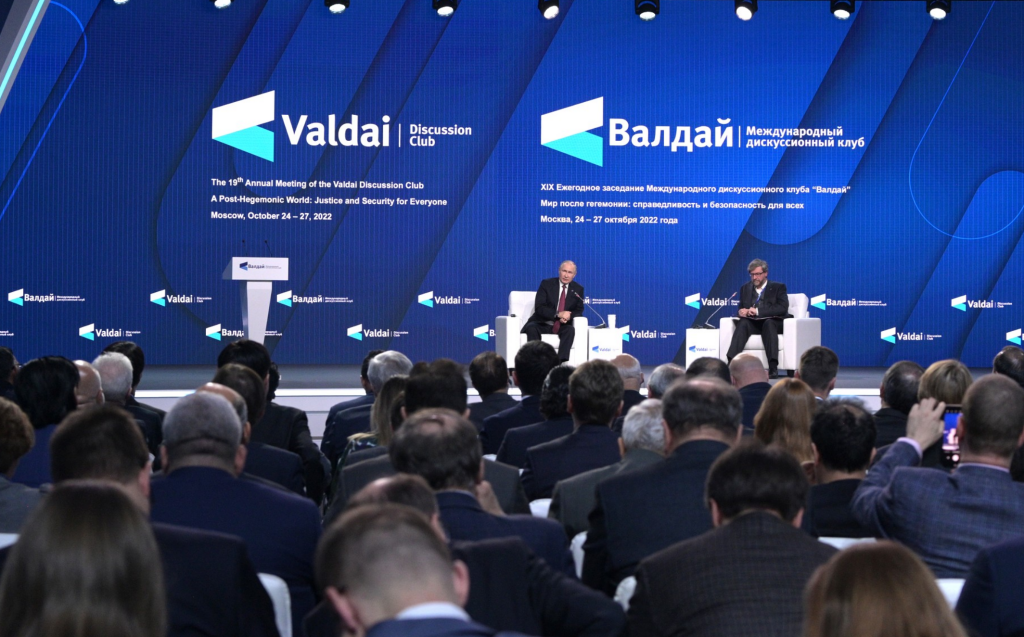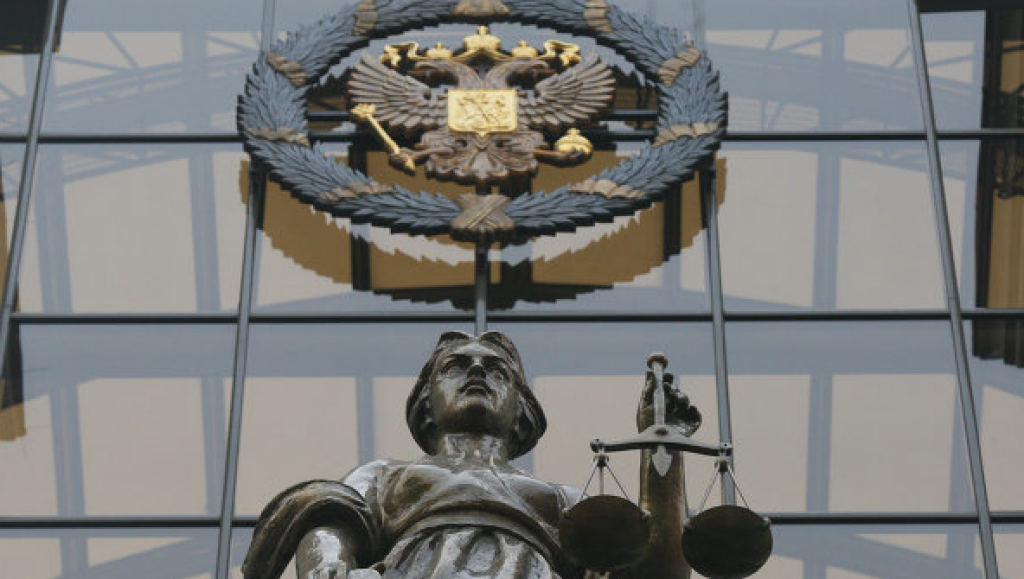The Jordan Center stands with all the people of Ukraine, Russia, and the rest of the world who oppose the Russian invasion of Ukraine. See our statement here.
Tora Berge Naterstad is a research fellow at the Norwegian Institute of International Affairs (NUPI). Her research focuses on Russian identities in international relations. This post is based on research conducted for a chapter in a forthcoming book on values-based regime legitimation in Russia, edited by Pål Kolstø and Helge Blakkisrud.
Above: Putin at the 19th meeting of the Valdai Discussion Club in October 2022.
Since 2012, Russian authorities have adopted a strongly anti-liberal rhetoric rife with attacks on Western secularism, multiculturalism, and alleged moral decay. But what does Vladimir Putin mean when he talks about “conservatism”?
In the LegitRuss project, we examine values-based regime legitimation in Putin’s Russia, asking whether Putin’s promotion of “traditional values” resonates with the public at large. As part of the project, we have looked into, among other things, grassroots conservatism and popular support for the conservative agenda. We also study the legitimation messaging from the Kremlin, what it communicates, and how this communication has changed over time. In his 2021 speech at the Valdai Discussion Club, Putin described an “ideology of healthy conservatism” as being
primarily about reliance on a time-tested tradition, the preservation and growth of the population, a realistic assessment of oneself and others, a precise alignment of priorities, a correlation of necessity and possibility, a prudent formulation of goals, and a fundamental rejection of extremism as a method.
More concretely, Putin specifies three dimensions of “healthy conservatism”: (1) refraining from responding radically to new challenges; (2) having a solid support in the sphere of morals, ethics, and values; and (3) upholding the supremacy of nation-states.
While the speech was neither a full-fledged ideological manifesto nor a window into Putin’s true guiding principles (whatever those may be), it can nevertheless serve as a focal point and a useful prism through which to study Putin’s self-declared “conservative” narratives. We have traced the recent genealogy of these three dimensions in a software-assisted qualitative text analysis of the kremlin.ru archives using a digital tool called corporaexplorer.
Putin’s project has always been “conservative” in the sense that its main selling point has been the anti-radical promise of stability. After a turbulent decade of unpredictability, democratic and economic “shock therapy,” poverty, and societal disintegration following the collapse of the Soviet Union, Putin’s ability to deliver a return to order and economic stability during his first two terms in office (2000–2008) made him a very popular politician. In the 2021 Valdai speech, Putin claimed that historical experience has given the Russian people “herd immunity to extremism.”
While Putin’s governance was never liberal, the 2011–2012 anti-government protests that rocked the regime mark a watershed when it came to “conservative speech” and alleged threats to stability. Tellingly, the semantic space occupied by the term “extremism” in Russian presidential discourse has gone through drastic changes over the last two decades. If, at first, it pertained to the fight against terrorism, the implied antagonist has shifted from the ultra-nationalist opposition to, most recently, a broad spectrum of oppositional actors and actions. This “conservative” rejection of extremism speaks not only of conservatism as “stability”, but of conservatism as “control.”
References to “tradition” have also become more frequent throughout the last decades. Around 2013–2014, the word became linked to conservatism. At about the same time, its use changed from referring to the traditions of individual ethnic groups to meaning the traditions of the entire Russian people.
The discourse that developed around Russian tradition answered a call Putin made in his 2012 address to the Federal Assembly, when he argued that that “to revive the national consciousness, we need to link together historical eras.” The result was a linear, continuous, and singular presentation of Russia's history, along with the claim that what unifies Russia’s many pasts is found in the sphere of values. At one point, Putin referred to The Moral Code of the Builder of Communism, adopted under Khrushchev during the 22nd Communist Party Congress in 1961, as “a pathetic copy of the Bible." He meant, evidently, that both texts represent the same values, which are inherent and traditional to Russian society.
This brings us to the second dimension under discussion: morals and values. The "Russian way" is framed as an alternative to the postmodernity and moral collapse of Europe and the West, while Russian “traditional values” are called upon to represent the "true" values of European classical modernity—i.e., those developed pre "perversion." Key themes in this realm include “family values,” skepticism towards sexual minorities, patriotism, religion, and collectivism.
In 2019, Putin stated that one of these traditional values, allegedly inherited from the ancestors, is “the ability to understand and accept different points of view, traditions, ways of life, and not impose one’s own model as an axiom”. Here, “healthy conservative” traditionalism and sovereign-ism link up. Putin’s speeches repeatedly express concern over a systematically hypocritical liberal international order pushing a destruction of traditional values “from above.” This narrative was already circulating well before Putin's return to power in 2012, but really came to the fore in 2013–2014, and then again from 2019 onwards.
Tracking the third dimension, the supremacy of nation-states, makes clear that Kremlin discourse on sovereignty does not necessarily follow a territorial or institutional logic. In 2021, Putin invoked “spiritual, cultural and national self-determination”. Some ten years earlier, a United Russia representative explained—using a quote from philosopher Nikolai Berdyaev (1874-1948)—that “the will of the people is not the will of a human generation, but the will of all historical generations” that includes “historical legends and traditions." In these framings, legitimate sovereignty comes from representing the soul of the people, not the accumulated will of individual citizens. The way the meaning of sovereignty has transformed to reflect the turn toward values-based official nationalism rationalizes a change in who can be seen as belonging not only to the Russian national community, but to the legitimate Russian geopolitical sphere.
In Kremlin discourse, “conservatism” is invoked most actively in relation to accelerated change, not continuity. Some examples here include the crackdown on freedoms, the annexation of Crimea, and the 2020 amendments to the Russian constitution. Indeed, according to Putin, “healthy conservatism” is all about moving forward. The rationale he constructs does not weigh against change, but rather constructs a hierarchy in which some possible changes can be deemed more “conservative” than others, therefore “more Russian,” and therefore better. Alternatives are not only unproductive, but un-Russian.
In 2020, Putin argued that a “strong, free, independent civil society is, by definition, nationally oriented and sovereign […] not the product of an abstract transnational mind, behind which other people's interests are hidden.” This presentation of anti-conservative threats conflates a discursive front against the West with a front against “immoral” ways of life at home, effectively framing anyone who fails to conform as an emissary of enemy powers and a danger to Russian sovereignty.
In conclusion, we can speak of three ideal-typified incarnations of Putinist conservatism—and trace their specific chronology. Putin began his time in power with consistent emphasis on “stability.” Then, around 2011–2012, he started using "stability" more actively to legitimize a broader crackdown on freedoms. Ultimately, all challengers to Putin’s rule came to be portrayed as agents of chaos or extremists. Around 2013–2014, traditionalism became conventionalized. The discourse that emerged after this point makes radical claims and opposes “moral degenerates” at home and abroad. It seeks to dictate the content of politics directly and is also more prescriptive of what it means to be Russian.
As the Kremlin's definition of conservatism evolved, it moved from privileging stability, to emphasizing control, to, finally, understanding conservatism as traditionalism. These shifts were both gradual and reactive, responding to changing domestic and external circumstances. The “healthy conservatism” of 2021, where our study culminates, provides a useful ideological platform for the full-scale invasion of Ukraine only months later. However, this outcome diverges sharply from the original premise of conservatism in Putin’s discourse—stability.



